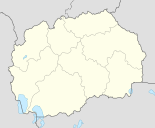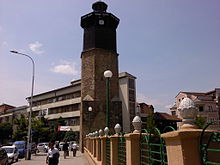Gostivar
| Gostivar Гостивар Gostivar / Gostivari |
||||
|---|---|---|---|---|
|
||||
| Basic data | ||||
| Region : | Polog | |||
| Municipality : | Gostivar | |||
| Coordinates : | 41 ° 48 ' N , 20 ° 55' E | |||
| Height : | 533 m. i. J. | |||
| Area (Opština) : | 513.39 km² | |||
| Residents : | 37,030 (2016) | |||
| Inhabitants (Opština) : | 83,725 (2016) | |||
| Population density : | 163 inhabitants per km² | |||
| Telephone code : | (+389) 042 | |||
| Postal code : | 1230 | |||
| License plate : | GV | |||
| Structure and administration | ||||
| Mayor : | Arben Taravari (APSH) | |||
| Website : | ||||
Gostivar ( Macedonian Гостивар , Albanian also Gostivari , Turkish Gostivar ) is a city in North Macedonia and is located in the Polog region in the northwest of the country. It is the official seat of the Opština of the same name , which in addition to the city also includes surrounding villages and is around 513 square kilometers in size. Gostivar is located at the eastern foot of the Šar Planina Mountains (Alb. Mali i Sharrit ) and is an important industrial and commercial location in western North Macedonia.
geography
Gostivar is located in the upper part of the Polog plain on the course of the Vardars , which rises about six kilometers southwest near the village of Vrutok and divides the city into north and south halves. The plain is one of the most important agricultural areas in Macedonia. Gostivar is between 520 and 550 m. i. J. . In all directions with the exception of the north mountains rise, those in the west with the peaks of the Šar Planina up to 2000 m. i. J. reach. To the south rises a densely forested hill country crossed by rivers. In the east there are some mountain ranges with up to 1500 m. i. J. and the Kozjak reservoir .
population
city
According to the 2002 census, the city of Gostivar had 35,847 inhabitants. Of these, 16,890 identified themselves as Albanians , 11,885 as Macedonians , 4,559 as Turks and 1,899 as Roma .
16,877 residents stated Albanian , 13,843 Macedonian , 4,423 Turkish and 301 Romani as their mother tongue.
Opština
Ethnic composition of the Opština in 2002:
| Ethnicity | Share absolute | percentage |
|---|---|---|
| Albanians | 54.038 | 66.67% |
| Macedonians | 15,877 | 19.59% |
| Turks | 7,991 | 9.86% |
| Roma | 2,237 | 2.76% |
| Serbs | 160 | 0.19% |
| Other | 739 | 0.91% |
| Total | 81,042 |
Note: the percentages are rounded to two decimal places.
name of the city
Gostivar is made up of the Slavic word "gosti" for guests and the Turkish word "dvar" for palace or castle. The first written mention of today's name Gostivar goes back to the year 1313, in which the place can be proven in the declaration of the Serbian king Stefan Uroš II Milutin
history
The oldest document to date that mentions the city (indirectly) is a description by the Roman historian Titus Livius (59 BC to 17 AD): the last king of Macedonia Perseus is said to have 10,000 soldiers after the conquest of Uscana ( today's Kičevo ) marched into Euneum (today's Tetovo ) and conquered the city. During the march he is said to have taken the town of Draudacum , which is said to have been between the two towns. This town is believed to be today's Gostivar.
In 1566 the Ottoman clock tower (Alb. Kulla e Sahatit ) was built. In 1676 a mosque ( Albanian Xhamia e Sahatit ) was built next to it , which is now considered the center of the Muslim community in the Gostivar region. 1688 is madrassah built near the clock tower, it becomes the first school in the city. It also houses a large library in its building complex.
After the Serbian occupation of Gostivar in 1913, there was an uprising among the Albanian population, with 300 Muslims in the city - although not involved in the uprising - were led out of the city by the Serbian military and murdered.
On July 30, 1969, a serious railway accident occurred near Gostivar when escaped freight cars collided with a railcar . 29 people died.
In July 1997 the city administration under the then mayor Rufi Osmani ( RDK ) hoisted the Albanian flag in front of the town hall as a protest against the minority policy of the Macedonian government . The Macedonian police then reversed the action, which led to street demonstrations by the urban population, demanding equality of ethnic groups in Macedonia and trying to protect the Albanian flag from further removal. In total, over 10,000 people moved through the city. More than 4,000 police units then occupied the main streets and cut the power and telephone lines. Afterwards there were violent clashes between the Macedonian police and the demonstrators. Two people were killed trying to protect the Albanian national flag on the flagpole from the police. They are considered martyrs for the Albanians today. Over 80 other people were injured and several were arrested. The event was one of several bloody clashes between Albanians and Macedonians (or Macedonian police and army forces) that have flared up again and again since the republic's independence in 1991. The ethnic conflict even led to civil war-like conditions in 2001 , which resulted in several dozen victims on both sides. With the framework agreement of Ohrid a ceasefire was agreed with the paramilitary units of the Albanians and a legal basis was created for the equality of the ethnic minorities. Since then the situation has calmed down, but the agreed agreement has still not been implemented 100 percent.
Attractions
Gostivar is known for its clock tower ( Sahat Kulla ) and its old town with the Ottoman town houses. In the area there are many sights such as the source of the Vardar , the mountain Bistra , the many deciduous forests, the monastery Sveti Jovan Bigorski and the Korab , the highest point in the country.
Culture
As in the rest of Macedonia, Burek (alb. Byrek / -u ) is also a popular dish in Gostivar. In the city and the surrounding area, the culinary specialty is traditionally roasted under a metal spherical hood (alb. Saç / -i ) that has glowing ash on its surface and so cooks the baked goods under the influence of heat. The dough is made in Gostivar with butter and the filling usually consists of minced lamb, potato cubes and oregano. There are also variations with spinach leaves, peppermint, pumpkin or a cheese and egg filling.
education
In addition to the ten primary schools, there are three secondary schools and one college in the municipality of Gostivar . The Yahya Kemal College was opened 1999th
In addition, the state-accredited private university "International Vision University" has been offering higher education in Turkish since 2015 and thus accommodates several hundred students from Turkish-speaking countries every year.
economy
Gostivar is a trading town. From the second half of the 19th century, many traders from Kruševo , Kičevo , Tetovo and Veles opened their shops.
traffic
Private transport
Gostivar is one of the largest cities in the country and has good road connections to Tetovo , Debar and Kičevo . The city has a relatively good infrastructure. In 1995 a 28 km long motorway was built from Gostivar to Tetovo, which continues to Skopje (approx. 65 km). The roads to Kičevo and Debar are comparatively old and in certain sections very winding, but in good condition. A new traffic artery between North Macedonia and Albania will in future lead between Gostivar and the border - this route, called Rruga e Arbërit , will on the one hand shorten the journey time from Skopje to Tirana by a few hours and on the other hand relieve the busy road between Kičevo, Struga and Elbasan . The latter is part of the inter-Balkan infrastructure project Corridor VIII and is to be expanded in the coming years.
railroad
Gostivar has a train station on the Skopje – Kičevo railway line . During the First World War, the line was initially built as a narrow-gauge railway with a gauge of 600 mm as the Skopje – Ohrid railway line . The standard-gauge line has stretched from Skopje to Gostivar since 1952 , and has continued to Kičevo since 1969 .
air traffic
The international airports of Skopje and Ohrid are around 90 and 100 km away.
Local transport
Inland traffic today is mostly handled by cars. However, there are also a few taxi and especially bus companies. Buses run to the largest villages every day at quarter-hour or half-hour intervals. Small buses and coaches run daily to Tetovo, Skopje, Debar, Tirana , Pristina , Belgrade , Istanbul and Zagreb . Some bus companies also list some Western European destinations, such as E.g. Vienna , Linz , Düsseldorf , Hamburg and Rome , to which buses go weekly.
Personalities
sons and daughters of the town
- Rufi Osmani (* 1960), politician
- Shaban Ismaili (* 1989), soccer player
- Admir Mehmedi (* 1991), soccer player and Swiss national player
- Gentjana Rochi (* 1994), soccer player
People associated with the city
- Xhem Hasa (1908–1945), activist and troop commander of the Balli Kombëtar in World War II
Web links
- Official websites in Macedonian , Albanian and Turkish
Individual evidence
- ↑ 2002 Census (cities), p. 87 (Macedonian and English) (PDF; 2.3 MB)
- ↑ 2002 Census (cities), p. 225 (Macedonian and English) (PDF; 2.3 MB)
- ↑ 2002 Census (municipalities), p. 34 (Macedonian and English; PDF; 394 kB)
- ↑ Thammy Evans: "Macedinia" Publisher: The Globe Pequot Press Inc., Guilford, 2004, 228
- ↑ a b Historiku i Qytetit
- ↑ The Struggle for the Flag in: Koha from July 15, 1997 (English)
- ↑ Burek. Common Ground Consulting, June 4, 2007, accessed January 30, 2016 .
- ↑ Arsimi në Gostivar and Yahya Kemal College: History ( Memento of the original from August 31, 2011 in the Internet Archive ) Info: The archive link was automatically inserted and not yet checked. Please check the original and archive link according to the instructions and then remove this notice.
- ↑ Official website: "www.vizyon.edu.mk"
- ↑ Transporti në komunën e Gostivarit on the website of the municipality







